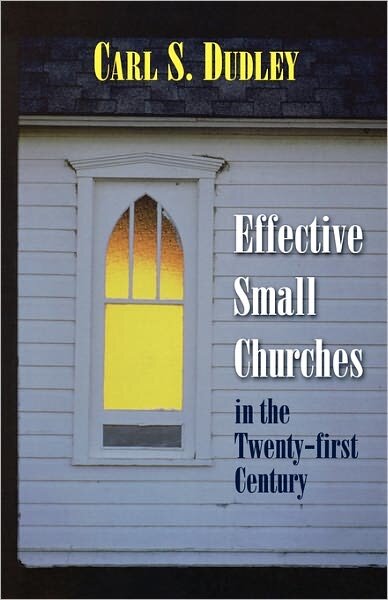Carl S. Dudley, Effective Small Churches in the Twenty-First Century Revised edition. Abingdon Press, 2003.
Referenced in: Small Church Leadership
LifeandLeadership.com Summary
This is completely updated from the 1978 edition by Carl S. Dudley and Douglas Alan Walrath, Developing Your Small Church’s Potential. Many of the insights in this revised edition are based on The Faith Communities Today (FACT) Report (2000), sponsored by the Hartford Seminary Institute for Religion Research. FACT is one of the largest and most inclusive studies on faith communities in the United States, having surveyed 14,301 congregations from 41 denominations. FACT reveals that half of all congregations in the United States have less than 100 Regularly Participating Adults (RPA). This book is written in appreciation of these churches.
Dudley argues that many of these churches, despite the unique struggles of smaller faith communities, are actually doing quite well. He adds that the “basic relational power of small churches has been enhanced by several new developments in the last quarter century.” (11) The purpose of this book is to suggest strategies to adapt to these new conditions regarding the practice of worship, growth, pastor/people relations, church events, vision, etc. In addition, Dudley suggests new resources in the literature for small churches in developing social capital, congregational culture, faith practices, niche identity, electronic communities, and network communities. The FACT research is interwoven with the recommended strategies.
The book is divided into three parts: Caring, Belonging, and Sharing. Part one, Caring, discusses the basic concept of primary relationships that provide the strength and lasting appeal in small churches. It describes the place of persons in the “caring cell,” the special dynamics of growth by adoption, and the pastor/people tensions relative to program and leadership. Small church leaders must work in each of these areas so as to insure that the congregation always “feels like a close knit family.”
Part two, Belonging, discusses the fact that for initiated members of small churches, being in that place evokes personal memories and shared experiences, and that preserving those memories is important to them. “Small churches are not against change. They simply feel that preserving the past has priority.” (86) Dudley says small congregations affirm the past as their source of identity in three ways: time, annual events and personal passages, and history.
Part three, Sharing, stresses that faith must move past the experience of caring and belonging to actually sharing in the present and anticipating the future. Dudley suggests that “the small church must use its experience of caring and its style of belonging as its foundations for sharing.” (134) It does this by clarity of purpose that fits with their identity and fortifies them during conflict, by comfort with the kind of quiet witness they make in their community and beyond, and by sharing with others across faith differences. His chapter on “Energizing From Within” is especially helpful, showing how outreach is conditioned by the special identity, or “turf type” of each congregation (e.g. pilgrim church, prophetic church, servant church, intentional church, survivor church).
Of special value are the “Congregational Exercises” that precede each chapter. These include activities to help churches understand and value themselves regarding the choreography of worship; matriarchs, patriarchs, and gatekeepers; congregational timelines; the silent history of the church; the calendar of annual church events; church groups, goals, and purpose; ministry map; and the church community map.
There is valuable information in this text. It provides the special touch that can only come from a sociologist of religion who truly loves the local church. This is not necessarily the best book on morale building, strategy, or inspiration (it’s a heavy read at times), but the small church leader’s understanding of his or her ministry context would not be complete without reading this volume.
From the Publisher (description of old edition)
Is your church’s future frozen in memories of the past? Is the congregation caught in a “collision of cultures” or struggling to survive its dwindling membership? Here’s encouragement and guidance to help your members find new possibilities within the community and develop the church’s potential for faithful Christian witness.
The authors explore typical rural, exurb, suburban, and city churches – their historical/social roots and the impact of population changes on their congregations. They suggest innovative approaches for:
- Making positive use of community transition
- Absorbing newcomers into the church family
- Reshaping the church’s image to widen its appeal
- Using the past as a bridge to the future
- Resolving cultural conflicts
- Developing programs reflecting community needs and other concerns.
Editorial Reviews (for old edition)
“If you are serving a small-membership church or if you are a member of a small-membership church, Developing Your Small Church’s Potential is a book you will want to read…This book should be used when a church is developing its vision statement or looking for a mission. Consider giving a copy to each council member; then your church may develop an appropriate strategy for change.” – Dr. Randy Hardman, General Board of Discipleship, United Methodist Church.
About the Author
Carl S. Dudley is a faculty member at Hartford Seminary and a researcher at the Hartford Institute for Religious Research. He is an authority on congregational studies and the relationship between congregations and their communities.
***For additional information on this resource, including reviews, click the bookstore links. Check the reference at page top or the links below for resource guides on related topics.***
See Resources on Over 100 Areas of Ministry Leadership:


